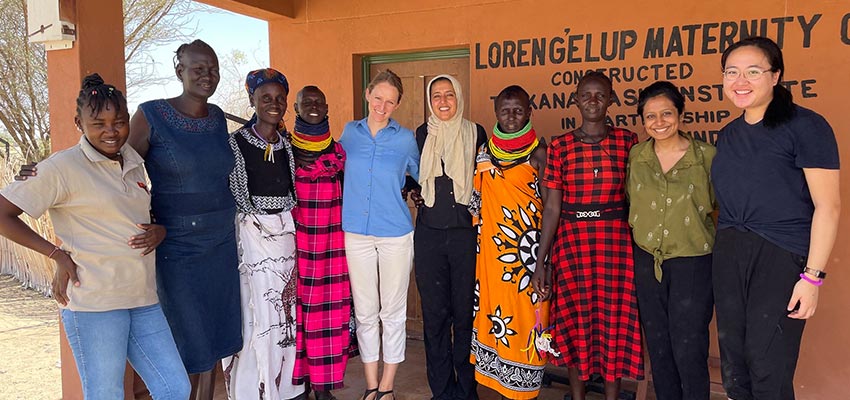
Dust may settle, but it lingers. It’s been a few weeks since I’ve returned from my group’s D-Lab: Development trip to Kenya, and I still think about the rich, eye-opening experiences we had during our three weeks there. While I am now far from the hot, dusty winds of Turkana County, I still can brush off patches of dust from my backpack. Each dusty pat has the potential to resurface memories big and small, reminding me of the people and places that entered my heart. This short blog post can cover some of them, but it’s mostly just the tip of the iceberg (or sand dune, if you will).
Meet the team
Three MIT students congregated in Kenya from different parts of the world in January to carry on the work we started during our D-Lab: Development class in the fall. Our fearless trip leader was Ipshita Karmakar, a second-year Master of City Planning (MCP) student and our class’s teaching assistant. On the team was Soad Mana, also a second-year MCP student. And I’m Shulammite Lim, a first-year MEng (Master of Engineering) student in Computer Science and Molecular Biology. We were advised by Megha Hegde, a Research Associate with MIT D-Lab. And on the ground in Kenya, our main Turkana Basin Institute contact (and the key person who made ALL of our Kenya activities fall into place) was Acacia Leakey, the Technical Initiatives Manager at Turkana Basin Institute (TBI), our partner organization.
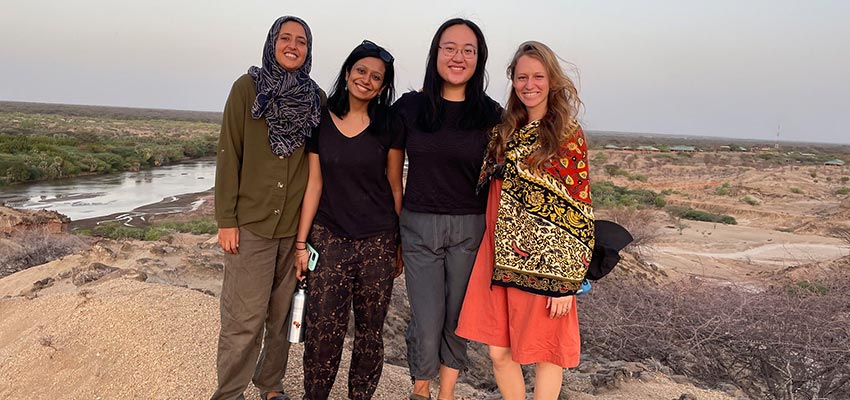
A little more about TBI: TBI is an international research institute that supports research and education in paleontology, archeology, and geology in the Lake Turkana Basin of Kenya. The three campuses–TBI-Nairobi, TBI-Turkwel, and TBI-Ileret–comprise TBI Kenya, which is under an agreement with the government of Kenya to serve as a repository for the region’s archaeological and paleontological heritage. TBI also runs a mobile clinic, which provides healthcare services to nearby communities. We stayed at the TBI-Turkwel location, situated along the Turkwel River in the northwest county of Turkana. There, TBI supports existing healthcare outreach from the government and NGOs, which was the focus of our trip.
Turkana: beyond the heat
After flying into Nairobi, Kenya’s capital, we set off to Turkana, where we spent the majority of our time. Getting to Turkana wasn’t particularly feasible by car, and I soon saw why: while staring out the airplane window, I saw the Nairobi cityscape melt into green fields, which yellowed until they formed a nearly uniform swath of sandy desert, punctuated only by what looked like small shrubs (I’d later recognize them as short trees). Without a paved road in sight, the only option for land travel would be to drive over unending kilometers of dirt roads, and the trip would end up taking the majority of a day. Thinking about this gave me my first shift in perspective. Having resided in urban and suburban areas all my life, my definition of “rural” was whatever relative sparseness I would drive through while road tripping. When my plane landed on an air strip that was simply a clearing in the desert landscape, with only plants as signs of life all around, I knew I had really gone “out there.” And this perspective shift would match many of the lived experiences and challenges I would come to observe. Resources would often be stretched thin, with the region’s inaccessibility forming a barrier to replenishment.
Dry heat greeted us when we stepped off the plane, and we unknowingly also said goodbye to air conditioning for (the vast majority of) the next few weeks. In its place, hot winds carried dust that would coat every available surface, and a strong sun would bake the sand (and any unprotected patch of skin) during the day. In the midst of all the heat, though, was TBI-Turkwel, whose dormitory and mess hall would shelter us (from the sun, at least) and allow us to carry out our work. This “home base” would foster many insightful conversations and productive planning/work sessions, and apart from the many other forms of support TBI provided, I have immense appreciation for the opportunity to stay there to work on the project.
Also, TBI is just so fascinating. Acacia graciously gave us multiple tours of the campus, and we learned about how the buildings were constructed from materials made on-site, putting an emphasis on local skill wherever possible. And the hydroponics garden was so cool!
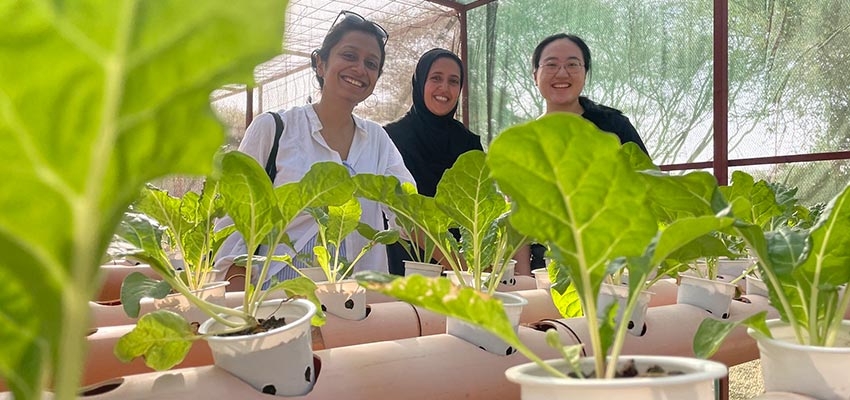
Information gathering
Our goal as the first D-Lab: Development group (and second D-Lab group overall) at TBI was to gather information surrounding a problem identified by local community health workers: measuring baby length during malnutrition outreach activities. For context, the severe droughts affecting Kenya have led to increased food insecurity and rising rates of child malnourishment and mortality. To combat this, TBI, along with the county government and other NGO partners, identifies and provides supplements to malnourished children through mobile clinics. The mobile clinics measure children's weight, height and middle upper arm circumference (MUAC) to determine whether they qualify for supplements, but the process of measuring height has proven strenuous. Health workers need to hold the children down against measuring devices, stressing both mother and child and making the work of health workers more difficult. This taxing method provides an opportunity to innovate and improve the mother, child, and health workers' experiences by developing an improved measuring tool.
To learn more about the local health context, we visited Kerio Health Center, as well as dispensaries (health facilities one level below health centers) in the communities of Lorengelup and Nakechichok. While we observed a general shortage of healthcare workers, we also witnessed a striking resilience in the present workers’ drive to care for those in their community. In a conversation with one nurse, we learned that he worked all day, sometimes even around the clock, to care for patients at the dispensary where he worked (babies can’t wait, he noted). We learned about problems faced by the healthcare workers and their patients, as well as inspiring success stories of helpful healthcare initiatives. We walked through the maternity wards and learned of many Turkana people’s hesitation toward Western medicine, as well as the effort nurses put into encouraging pregnant women to deliver at health facilities rather than at home, with the goal of reducing complications in labor and delivery (one example: incentivizing them with soap). Overall, these visits painted a picture of what healthcare looks like at the margins of Kenya, revealing an entirely different set of problems than what I had learned about in the American healthcare system, even for its rural reaches.
We also conducted interviews with several stakeholders in Turkana public health, including community health volunteers (CHVs), nurses, county government officials, and local NGO leaders. We learned about healthcare at the most local level and all the way to the county level. We met Linus Ekal, a CHV (and impressively, also a TBI employee and pastor) who was responsible for health concerns in his village of 21 households. Village members would come to him with ailments, and he would then refer them to the local dispensary, which could either treat the condition or refer upward to the closest health center. If the health center did not have the right staff or drugs on hand, it would refer the patient to the Lodwar County Referral Hospital, which was an hour’s drive away on motorbike. From the county and NGO perspective, we learned about the impact of the ongoing drought on public health, as well as the impact of the malnutrition program outreach and other initiatives.
Some of the most striking experiences for me were when we joined as observers during outreach by healthcare facilities to local villages. Each village’s CHV would mobilize the village to meet at a designated site (usually under a tree for shade), where healthcare workers would then offer services like malnutrition support for children under five years of age and pregnant women, as well as immunizations. In these villages, which were too far from healthcare facilities to reach them by foot, the outreach was critical. At the same time, funding and staffing were two major barriers to keeping outreach from occurring at a regular cadence. Watching the nurses and CHVs tirelessly measure and record health metrics at these makeshift sites, as well as the nearly one hundred patients gathered under a tree not far away, I was impressed with the simultaneous importance and fragility of regular, ongoing outreach to these remote villages. This would be where we focused our attention in brainstorming, aiming for small-scale innovation that could help facilitate these long outreach days.
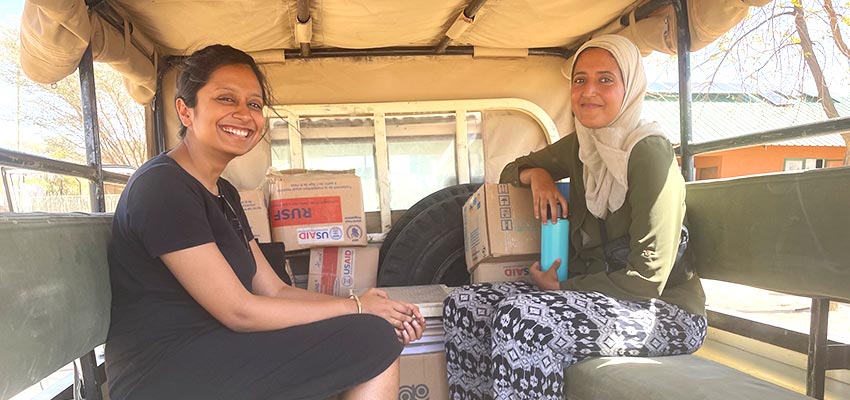
Running a workshop: mother knows best
With infant length measurement in mind, we ran (and simultaneously participated in) an idea generation and sketch modeling workshop with some stakeholders in Turkana health outreach: local mothers whose children had been in the malnutrition program, a health dispensary worker, and a chief (local leader). For translation between Turkana and English, we were joined by the lovely Christine Louriyen, a research assistant with TBI, who also participated in the workshop.
For the first half, we focused on ideation, warming up with fun, brainstorming-minded activities before focusing on the problem at hand. We also gave space for the mothers to share about frustrations they had with the malnutrition outreach: their babies struggled with CHVs attempting to measure their length against the height board laid flat on the ground. With the problem framed, we led activities to generate ideas for solutions, which focused around three main themes: distracting the baby, using a flexible measurement device, and making the baby more comfortable while lying down. We evaluated the ideas together using a Pugh chart, first identifying important criteria for a length/height measurement tool and then discussing which ideas met the design criteria.
With some potential solutions in mind, we then advanced to the sketch modeling part of the workshop, during which we covered a table with simple materials for use: pipe cleaners (a favorite), modeling clay, markers, paper, foam, fabric, and baby-sized dolls for reference. Then, each participant built a simple sketch model of their chosen idea. When we went around sharing our sketch models, I felt a strong affirmation of the line we said at the beginning to the workshop participants: “You are the experts.” The mothers were indeed experts at ways to make their children feel better (or at least distracted) while their length/height was being measured. I felt a strong rush of appreciation for all the workshop participants, who gave us time out of their days to follow along with the exercises and bring their authentic selves and experiences.
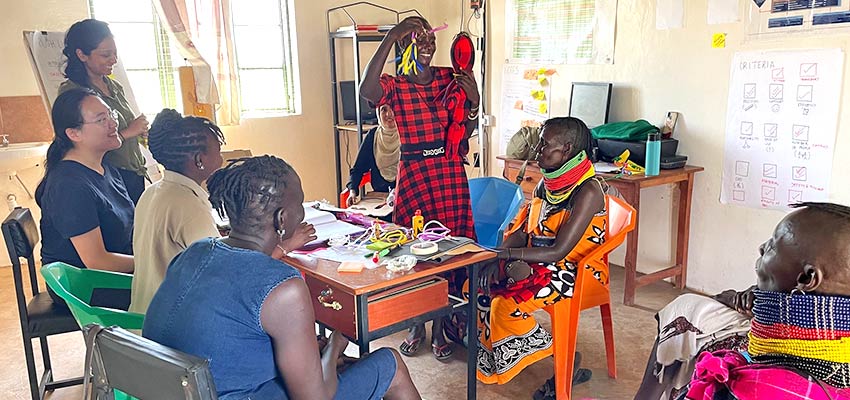
As we debriefed together from the workshop over mandazis (fried dough) and chai (tea), we heard participants express appreciation for being given a platform to share their lived experiences and ideas, as well as reflections on how there can be more than one way to approach a problem (e.g., measuring baby length). This workshop was powerful for me in giving me a window into how to start learning from local experts, and I hope that future D-Lab groups can build on the momentum from here.
Reflections
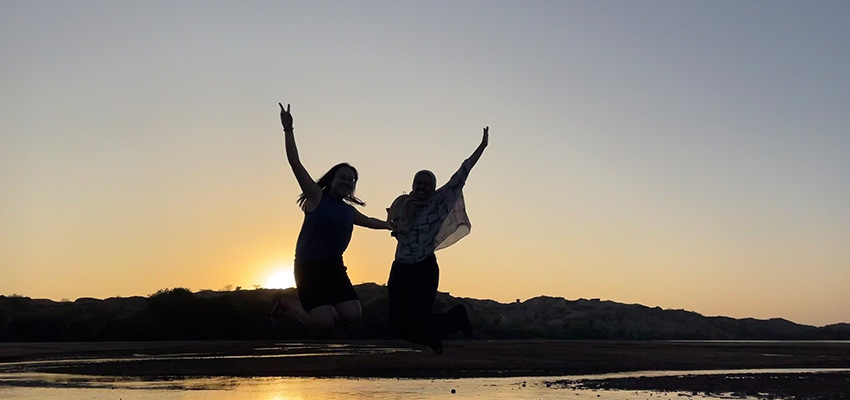
Each time I think back on my experiences in Kenya, I am filled with appreciation for the opportunity to have gone, as well a sense of the immense privilege I have being a student at MIT. Another privilege was getting to meet so many people in Kenya, and I was touched by their warmth and the openness with which they received us and shared about their lives. A day after I got back, Cambridge plunged to record-low temperatures, and I found it hard to believe that just a little while before, I had sweated in 100+-degree (Fahrenheit, or 38+ degrees Celsius) weather. Apart from weather, so many other differences between Turkana and Middlesex Counties make them like night and day. Despite the differences, both have carved out a space in my heart. Until next time, Turkana!
More information
Class: D-Lab: Development
Student project page: Mini MEter
Contact
Libby Hsu, MIT D-Lab Lecturer and Associate Director of Academics; Instructor, D-Lab: Development

